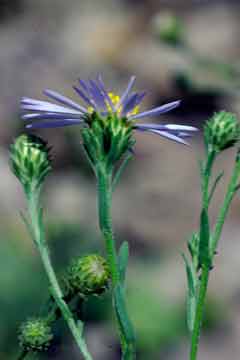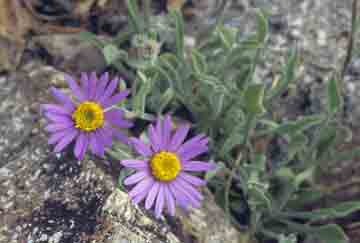
Note: Fleabanes, or true daisies (Erigeron spp.), have regular bracts--the leaves that cup the flowerhead--tend to bloom early in the summer, and while many are purple, they more often are yellow or white.
The Rough (Idaho) fleabane, Erigeron asperugineus ( D.C. Eaton) A. Gray (left).The rough fleabane is a lovely little plant distinguished by its many rayed purple and yellow flowers. It blooms in summer at high elevations on rocky ground. The genus name, Erigeron, is an old one, derived from the Greek: eri meaning “early“ and geron for “old man,” evidently because many flowers have grayish hairy leaves and stems. Our plant’s species name asperugineus means “rough” referring to brittle-feeling stems and crisped leaves.
Bear River fleabane, Erigeron ursinus D. C. Eaton (right), The Bear River fleabane is larger and showier than most erigerons. It is characterized by a basal cluster of narrow lanceolate leaves, and narrow stem leaves. The stem is stout, bearing a single flowerhead. A broad yellow disk is surrounded by 100 or so purple rayflowers. The Bear River, from which the plant’s name was derived, flows from Utah’s Wasatch Range to Bear Lake on the Idaho-Utah border, and thence to the Great Salt Lake. The Latin species name, ursinus, means “bear.”
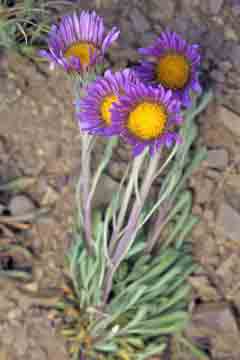
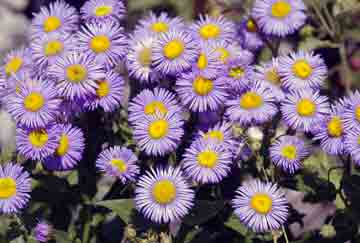
Foothill, or long-leaf daisy, Erigeron corymbosus Nutt. (right). As one of its common names suggests, the long-leaf daisy is a commonly encountered foothill plant (although it occurs as well at higher elevations). It prefers dry ground and is usually found in the company of sagebrush. The plant can be identified by its many rays (+/- 100) and long linear leaves that ascend the stem. The long-leaf daisy is found in all of the states and provinces contiguous with Idaho's borders, excepting Nevada. The species name was derived from the word "corymb" which implies a flat-topped cluster, apparently referring to this plant's disk.
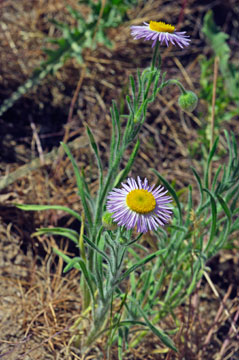
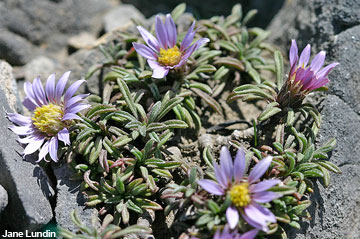
Mountain townsendia, Townsendia alpigena Piper (right). The townsendias are closely related to the fleabanes. The mountain townsendia is a small plant that grows at, or above treeline on alpine tundra. The plants are characterized by relatively large flowerheads borne singly on longish stems. Their central disks are prominent, and the rays range from a light purple color (usually) to near white. Its small basal leaves are covered with fine hair and the involucral bracts below the flowerhead are striped, a distinguishing feature. Twenty seven species of Townsendia are recognized; none grow east of the Mississippi River. David Townsend (1787-1858), for whom the genus was named, was an amateur Pennsylvania botanist.
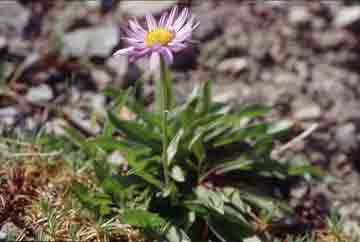
The "asteroids" (plants formerly in the genus Aster), include Symphyotrichum, Ionactis, Eucephalus, Machaeranthera, and several other genera. These have irregular "shingled" bracts below the flowerhead, tend to bloom later in the summer than the fleabanes, and most are purple.
Leafy aster, Symphyotrichum foliaceum (Lindl. ex DC.) G. L. Nesom var. apricum (A. Gray) G. L. Nesom (left). The leafy aster is found throughout the West, blooming from mid-summer on. They have large, stemmed, basal leaves and smaller “clasping” (stemless) leaves higher up. Each stem bears one flowerhead, often with fifteen rays. As the flowers mature, the central bright yellow disk becomes brownish, and the petals darken to a rich, deep purple—a distinguishing feature. Several varieties are recognized by minor differences in their morphology. Var. apricum, (“apricum” means “sun-loving”), the plant shown here, has purple-margined bracts (the small leaflets that cup the flowerhead). It is common along our trails. The plants bloom from mid-summer on
The Hoary Aster, Machaeranthera canescens var canescens (Pursh) A. Gray (right). Machaeranthera is a word derived from the Greek, meaning "sword" plus "anther," referring to its sharp-pointed anthers. The plants bloom in summer's heat from the end of July well into August, always in dry places. It has adapted to a xerophytic life with a furry stem (canescens means "covered with short white hairs") and spiny bracts. These and its white-based purple rays, and orange disk help to identify it. Many varieties are recognized. Meriwether Lewis collected a hoary aster (another variety, incana, that grows more to the west) on the Columbia River in October of 1805.
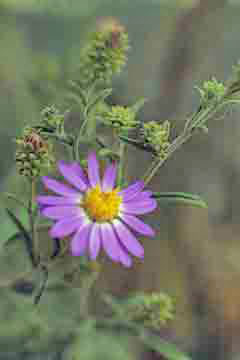
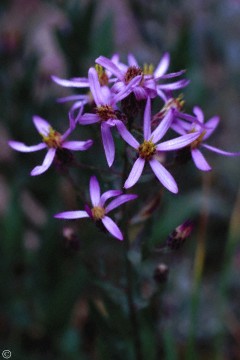
Rocky Mountain aster, Ionactis stenomeres (A. Gray) Greene (right). Formerly classified as Aster stenomeres, the Rocky Mountain aster's attractive flower-heads bear thirteen (or occasionally more) narrow rays. The word stenomeres, from the Greek, means “narrow-parts” presumably referring to its narrow, same-sized leaves that ascend the stem. Ionactis is also derived from the Greek, and means “violet rays” (cf. “actinic”). This plant is often seen growing in aggregates as shown here
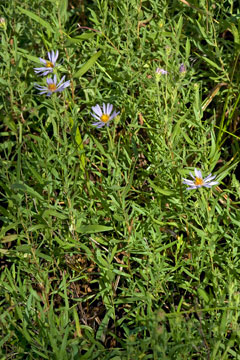
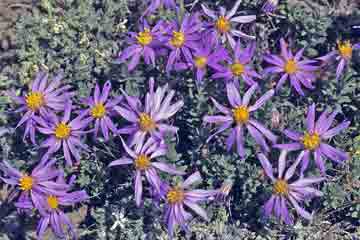
Alpine aster, Oreostemma alpigenum (Torr. & A. Gray) Greene var. haydenii (Porter) G. L. Nesom (right) is a subalpine to alpine species that also grows in clusters in open spaces. Botanists recognize three varieties; only this one grows in Idaho. The plant has a basal crown of linear gray-green leaves. These, the stem, and purple-tinged bracts are covered with fine hair. The generic name Oreostemma, derived from two Greek words, means “mountain crown.” To avoid confusion with other alpine asters the name “tundra mountain crown” has been suggested for this plant.
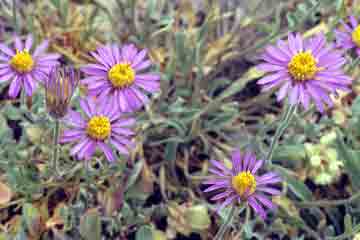
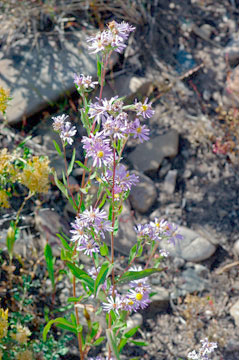
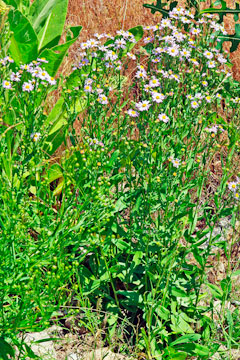
Thick-stem aster, Eurybia integrifolia (Nutt.) Nesom or Aster integrifolius Nutt. (left, right). Confusingly, both binomial names listed are currently in use. This is a mid-elevation mountain plant that blooms in mid-summer on dry gound. Tall for an aster, its stems arise from a cluster of large, smooth-edged (integrifolia) leaves. Each stem divides into several to many stemlets that bear small (<1" diameter) purple-rayed flowerheads. These have from 10 to 27 ray flowers, and a raised, yellow disk. The involucre that cups the flowerhead is made up of a row of wide outer bracts and darker, narrower, inner ones. The thick-stem aster is found in the four northwestern states, and in Wyoming, south to Utah, Nevada and California.
